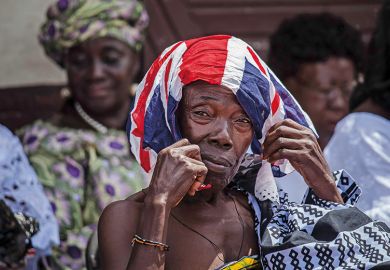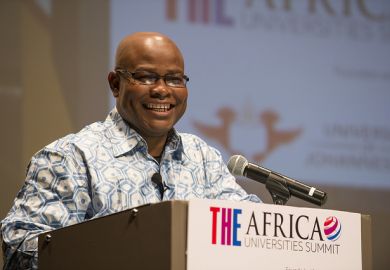“This century will be the African century, so students who want to be globally equipped will have to understand where Africa’s going.”
Fred Swaniker has just finished explaining why he is confident that his new vision for African higher education will be a global success.
In 2013, Mr Swaniker – a Ghanaian educationalist and entrepreneur – founded the African Leadership University (ALU), which aims to “reinvent the university experience” for the 21st century. He hopes that, by 2060, ALU will have contributed to the training of 3 million entrepreneurial and ethical graduates, many of them from outside Africa.
To fulfil this ambition, Mr Swaniker envisions the construction of 25 campuses across the continent over the next two decades, each providing higher education for 10,000 students from Africa and beyond. So far, there are two campuses – in Mauritius and Rwanda – with more than 300 students enrolled.
Mr Swaniker told Times Higher Education that there was “a unique opportunity” for his project given the “massive need for higher education in Africa”.
“Tertiary enrolment rates in Africa are only about 8 per cent, compared with 24 per cent in India and 60 to 70 per cent in the West,” he said. “There are 20 to 30 million students who graduate from high school every year, and universities can take only about 2 million of them.”
ALU has several guiding principles, but a “non-negotiable” core requirement is that students will have to learn skills including critical thinking, communication, self-leadership, leadership of others and entrepreneurial thinking.
“Education is not a one-shot game,” Mr Swaniker explained. “[Our] students spend eight months on campus and four months in employment. By the time they graduate, they have [completed] a year of work experience. Even [on campus] we try to break down the barriers as much as possible between academia and the real world.”
ALU has already been dubbed, somewhat prematurely perhaps, the “Harvard of Africa” by CNN, and Mr Swaniker hopes that it will eventually be recognised as one of the world’s top universities.
He is appealing for researchers to join the institution, with 14 research centres being set up to address major challenges facing not only Africa but the wider world too, such as urbanisation, climate change, education and healthcare.
“All these will be hubs of research where we have our own full-time faculty doing research…and we’re looking to create a space where faculty from all around the world who are interested in these topics will come and spend time on our campus and work with our existing faculty and students to create research and knowledge from Africa,” Mr Swaniker said.
In time, Mr Swaniker expects “about 25 per cent of our students to come from outside Africa”. While international students might be attracted to a paradise-like Mauritian campus, is he confident of drawing them to one in Kigali, Rwanda?
Mr Swaniker believes that the “transformative experience” will be enticing enough, noting that ALU already has students from Taiwan, the Netherlands and the US. Nevertheless, he concedes that potential students might be more interested in some campuses than in others.
“Some countries are perceived internationally to be safer places to visit, [to have] more beautiful scenery, so I expect some campuses [to be more popular],” he said. “It’ll probably be correlated to the ones that have the highest tourist destinations, such as Mauritius and Morocco. Parents will be more comfortable…they’ll know about the infrastructure, the healthcare facilities.”
Ambitious visions that promise to shake things up will often draw some criticism and threaten those invested in the status quo. Mr Swaniker acknowledges that his plans may encounter some administrative and ideological pushback from the continent, where cross-border higher education collaborations sometimes struggle to take off, yet he insists that ALU’s strategy has largely been well received despite some “suspicion”.
“People know [we] need new and different ways of doing things,” he said. “The feedback in most countries has been very positive. We have had a lot of governments and countries that have approached us to come and open campuses in their countries.
“We’re viewed differently by different institutions. Some welcome us with open arms and want to collaborate and work with us, and are willing to share their experiences with us. Some do see us as a threat and a disruption, but we just feel that the need is so great. We’re all here to serve [Africa].”
Of course, financing costs are also a consideration. ALU has already secured $40 million (£31 million) in funding through initial investment from Silicon Valley organisations, and Mr Swaniker said that investors in Africa and around the world are interested in his project.
Ultimately, however, Mr Swaniker’s belief that “much of the 21st century will be defined by what happens in Africa” is what gives him confidence for ALU’s future.
“We’re the youngest population in the world,” he said. “The rest of the world is ageing. Africa is young. For the world’s labour force, the energy, the innovations that will drive economic growth in this century – it has to be Africa, there’s nowhere else it’s going to come from.”
POSTSCRIPT:
Print headline: Pan-African cradle of 21st-century minds
Register to continue
Why register?
- Registration is free and only takes a moment
- Once registered, you can read 3 articles a month
- Sign up for our newsletter
Subscribe
Or subscribe for unlimited access to:
- Unlimited access to news, views, insights & reviews
- Digital editions
- Digital access to THE’s university and college rankings analysis
Already registered or a current subscriber?








